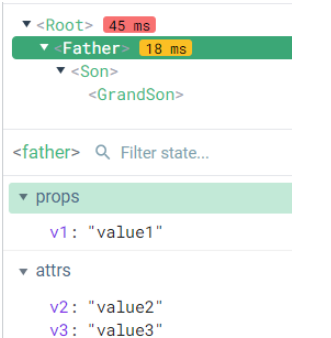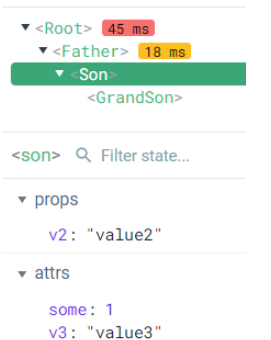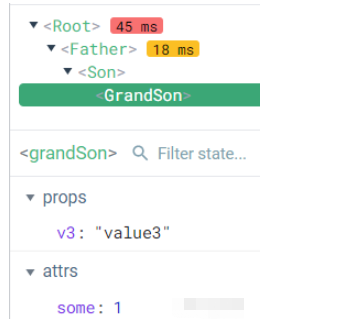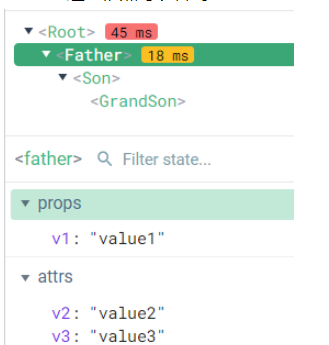vue3 $attrs和inheritAttrs怎么用
导读:本文共4213.5字符,通常情况下阅读需要14分钟。同时您也可以点击右侧朗读,来听本文内容。按键盘←(左) →(右) 方向键可以翻页。
摘要: $attrs和inheritAttrs用法$attrs属性解释:包含了父作用域中不作为组件 props 或自定义事件的 attribute 绑定和事件。当一个组件没有声明任何prop 时,这里会包含所有父作用域的绑定,并且可以通过 v-bind="$attrs" 传入内部组件——这在创建高阶的组件时会非... ...
目录
(为您整理了一些要点),点击可以直达。$attrs和inheritAttrs用法
$attrs属性解释:包含了父作用域中不作为组件 props 或自定义事件的 attribute 绑定和事件。当一个组件没有声明任何prop 时,这里会包含所有父作用域的绑定,并且可以通过 v-bind="$attrs" 传入内部组件——这在创建高阶的组件时会非常有用。inheritAttrs属性解释:如果你不希望组件的根元素继承特性,你可以在组件的选项中设置 inheritAttrs: false
可能不是很好理解,我们可以举个例子来验证一下。
在父组件app.vue中
<template><div><MyInputtype="text"placeholder="输入用户名"v-model="state.text"/><MyInputtype="password"placeholder="输入密码"v-model="state.pass"/></div></template>
<scriptsetup>importMyInputfrom"@/components/myInput.vue";import{reactive}from"vue";conststate=reactive({text:"",pass:"",});</script>子组件 myInput.vue 设置 inheritAttrs: true(默认)
<template><divclass="input"><inputv-bind="$attrs"v-model="modelValue"/></div></template>
<script>exportdefault{props:{modelValue:[String,Number],},};</script>
子组件 myInput.vue 设置 inheritAttrs: false
<template><divclass="input"><inputv-bind="$attrs"v-model="modelValue"/></div></template>
<script>exportdefault{inheritAttrs:false,props:{modelValue:[String,Number],},};</script>
小结:
由上述例子可以看出,子组件的props中未注册父组件传递过来的属性。
当设置inheritAttrs:true时,子组件的顶层标签元素中会渲染出父组件传递过来的属性(例如:type="text"等)
当设置inheritAttrs: false时,子组件的顶层标签元素中不会渲染出父组件传递过来的属性
不管inheritAttrs为true或者false,子组件中都能通过$attrs属性获取到父组件中传递过来的属性。
$attrs和inheritAttrs实例
官网的文档简短而又不清晰,实在是看不懂,只好自己找代码验证来看看是什么意思:
<!DOCTYPEhtml><htmllang="en"><head><metacharset="UTF-8"><metaname="viewport"content="width=device-width,initial-scale=1.0"><title>Document</title><scriptsrc="https://cdn.bootcdn.net/ajax/libs/vue/3.1.5/vue.global.js"></script></head><body><divid="app"><father:v1="'value1'":v2="'value2'":v3="'value3'"></father></div></body></html>
<script>constapp=Vue.createApp({data(){return{}},})app.component('father',{//inheritAttrs:false,props:['v1'],template:`<div><p>v1is{{v1}}</p> <sonv-bind='$attrs':some="1"></son> </div>`,created(){console.log('father:',this.$attrs)}})app.component('son',{//inheritAttrs:false,props:['v2'],template:`<div><p>v2is{{v2}}</p><grandSonv-bind='$attrs'></grandSon></div>`,created(){console.log('son:',this.$attrs)}})app.component('grandSon',{props:['v3'],template:`<p>v3is{{v3}}</p>`,created(){console.log('grandSon:',this.$attrs)}})app.mount('#app')</script>页面显示的结果:
v1 is value1
v2 is value2
v3 is value3
页面源代码:
<divid="app"data-v-app=""><divv2="value2"v3="value3"><!--这是father--><p>v1isvalue1</p><divv3="value3"some="1"><!--这是son--><p>v2isvalue2</p><psome="1">v3isvalue3</p><!--这是grandSon--></div></div></div>
控制台打印是当前组件的$attrs:
father: Proxy {v2: "value2", v3: "value3", __vInternal: 1}
son: Proxy {v3: "value3", some: 1, __vInternal: 1}
grandSon: Proxy {some: 1, __vInternal: 1}
首选,father组件被传入了3个值,但是实际使用props接收的只有v1,v2和v3作为attributes在DOM里面渲染了。

上图的devtool 也可以说明,另外就是控制台也同时证明了。
同样son组件只是接收v2作为prop:

grandSon组件只是接收v3作为prop

father prop:v1,attributes: v2,v3
son prop:v2 ,attributes:v3,some
grandSon prop:v3,,attributes: some
发现无论是father传入的3个值v1,v2,v3还是son又传入的值':some=1',
只要不被prop传入下一层组件,那么一定是在下一层组件的$attrs,也就是说不被作为prop的值会传入下一个组件作为attrs的一员。一个组件的attrs由父组件传递以及自己自带的组合而成。
上面说的是$attrs,那么inheritAttrs则说的是attrs继承,这里的继承是控制DOM渲染,不继承也就是不渲染了,但是实际还是存在这个attrs的。
`inheritAttrs`属性默认是true,所以能看到上面的结论,attrs会往下传,当设置为false的时候就不会在DOM渲染从上一层继承来的attrs。
修改一下代码:
app.component('father',{inheritAttrs:false,//不继承props:['v1'],template:`<div><p>v1is{{v1}}</p> <sonv-bind='$attrs':some="1"></son> </div>`,created(){console.log('father:',this.$attrs)}})father组件这不继承attrs,控制台的打印没变:
father: Proxy {v2: "value2", v3: "value3", __vInternal: 1}
son: Proxy {v3: "value3", some: 1, __vInternal: 1}
grandSon: Proxy {some: 1, __vInternal: 1}
devtool这里依然可以看到attrs

但是看源代码:
<divid="app"data-v-app=""><div><!--这里是father--><!--看这行--><p>v1isvalue1</p><divv3="value3"some="1"><!--这里是son--><p>v2isvalue2</p><psome="1">v3isvalue3</p><!--这里是grandSon--></div></div></div>
DOM渲染里面的v2,v3 attrs都不存在了。
</div> <div class="zixun-tj-product adv-bottom"></div> </div> </div> <div class="prve-next-news">vue3 $attrs和inheritAttrs怎么用的详细内容,希望对您有所帮助,信息来源于网络。